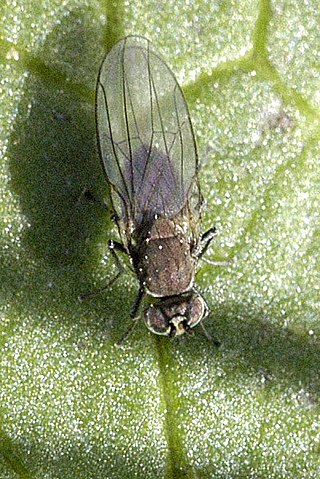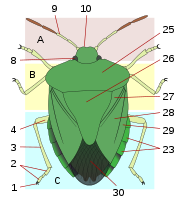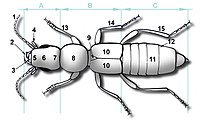
Ephydridae is a family of insects in the order Diptera.

The Asilidae are the robber fly family, also called assassin flies. They are powerfully built, bristly flies with a short, stout proboscis enclosing the sharp, sucking hypopharynx. The name "robber flies" reflects their expert predatory habits; they feed mainly or exclusively on other insects and, as a rule, they wait in ambush and catch their prey in flight.

Myrmicaria brunnea is a species of ant that is native to southern Asia. They have a distinctive down-curved abdomen and spines on the thorax.
The notum is the dorsal portion of an insect's thoracic segment, or the dorsal surface of the body of nudibranch gastropods. The word "notum" is always applied to dorsal structures; in other words structures that are part of the back of an animal, as opposed to being part of the animal's ventral surface, or underside.

The mesothorax is the middle of the three segments of the thorax of hexapods, and bears the second pair of legs. Its principal sclerites are the mesonotum (dorsal), the mesosternum (ventral), and the mesopleuron (lateral) on each side. The mesothorax is the segment that bears the forewings in all winged insects, though sometimes these may be reduced or modified, as in beetles (Coleoptera) or Dermaptera, in which they are sclerotized to form the elytra, and the Strepsiptera, in which they are reduced to form halteres that attach to the mesonotum. All adult insects possess legs on the mesothorax. In some groups of insects, the mesonotum is hypertrophied, such as in Diptera, Hymenoptera, and Lepidoptera), in which the anterior portion of the mesonotum forms most of the dorsal surface of the thorax. In these orders, there is also typically a small sclerite attached to the mesonotum that covers the wing base, called the tegula. In one group of insects, the Hemiptera, the dorsal surface of the thorax is typically formed primarily of the prothorax, but also in part by the enlarged posterior portion of the mesonotum, called the scutellum; in the Coleoptera, the scutellum may or may not be visible, usually as a small triangular plate between the elytral bases, thus similar in position to the Hemipteran scutellum. In Diptera and Hymenoptera the mesothoracic scutellum is also distinct, but much smaller than the mesoscutum.
The metathorax is the posterior of the three segments in the thorax of an insect, and bears the third pair of legs. Its principal sclerites are the metanotum (dorsal), the metasternum (ventral), and the metapleuron (lateral) on each side. The metathorax is the segment that bears the hindwings in most winged insects, though sometimes these may be reduced or modified, as in the flies (Diptera), in which they are reduced to form halteres, or flightless, as in beetles (Coleoptera), in which they may be completely absent even though forewings are still present. All adult insects possess legs on the metathorax. In most groups of insects, the metanotum is reduced relative to the mesonotum. In the suborder Apocrita of the Hymenoptera, the first abdominal segment is fused to the metathorax, and is then called the propodeum.
The cenchrus is a specialized anatomical structure in the insect group known as sawflies. The cenchri are small blister-like lobes on the metanotum of these insects, just posterior to the mesothoracic scutellum, shaped and positioned in such a way as to latch onto the base of the front wings when they are folded at rest. There are corresponding small patches on the wings where the membrane is roughened, to increase the friction against the dorsal surface of the cenchri. This is a unique mechanism among the insects.

The Agromyzidae are a family of flies, commonly referred to as the leaf-miner flies for the feeding habits of their larvae, most of which are leaf miners on various plants. It includes roughly 2,500 species, they are small, some with wing length of 1 mm. The maximum size is 6.5 mm. Most species are in the range of 2 to 3 mm.

Empididae is a family of flies with over 3,000 described species occurring worldwide in all the biogeographic realms but the majority are found in the Holarctic. They are mainly predatory flies like most of their relatives in the Empidoidea, and exhibit a wide range of forms but are generally small to medium-sized, non-metallic and rather bristly.

The Lonchaeidae are a family of acalyptrate flies commonly known as lance flies. About 500 described species are placed into 9 genera. These are generally small but robustly built flies with blue-black or metallic bodies. They are found, mainly in wooded areas, throughout the world with the exception of polar regions and New Zealand.

Parasyrphus is a genus of hover fly found in the holarctic area of the world including species like Parasyrphus tarsatus located in some very northern areas. Very few of the 31 identified species have known larvae. Of the known larvae most are predators of tree aphids with one, Parasyrphus nigritarsis, that feed on beetle eggs and larvae.

Toxomerus marginatus, also known as the calligrapher fly, is a common species of hoverfly. It is found in many parts of North America.

Conops quadrifasciatus, the yellow-banded conops, is a species of fly from the genus Conops in the family Conopidae.

Insect morphology is the study and description of the physical form of insects. The terminology used to describe insects is similar to that used for other arthropods due to their shared evolutionary history. Three physical features separate insects from other arthropods: they have a body divided into three regions, three pairs of legs, and mouthparts located outside of the head capsule. This position of the mouthparts divides them from their closest relatives, the non-insect hexapods, which include Protura, Diplura, and Collembola.

Platycheirus immarginatus, the Comb-legged Sedgesitter, is a common species of hoverfly. It is found in parts of northern Europe and northern North America.
Dipteran morphology differs in some significant ways from the broader morphology of insects. The Diptera is a very large and diverse order of mostly small to medium-sized insects. They have prominent compound eyes on a mobile head, and one pair of functional, membraneous wings, which are attached to a complex mesothorax. The second pair of wings, on the metathorax, are reduced to halteres. The order's fundamental peculiarity is its remarkable specialization in terms of wing shape and the morpho-anatomical adaptation of the thorax – features which lend particular agility to its flying forms. The filiform, stylate or aristate antennae correlate with the Nematocera, Brachycera and Cyclorrhapha taxa respectively. It displays substantial morphological uniformity in lower taxa, especially at the level of genus or species. The configuration of integumental bristles is of fundamental importance in their taxonomy, as is wing venation. It displays a complete metamorphosis, or holometabolous development. The larvae are legless, and have head capsules with mandibulate mouthparts in the Nematocera. The larvae of "higher flies" (Brachycera) are however headless and wormlike, and display only three instars. Pupae are obtect in the Nematocera, or coarcate in Brachycera.

Meromacrus acutus, the Carolinian Elegant, is a species of syrphid fly in the family Syrphidae. This uncommon species is distributed in the Eastern United States and South America. Notable for the black and yellow pattern mimicking wasps. Hoverflies get their names from the ability to remain nearly motionless while in flight. The adults are also known as flower flies for they are commonly found around and on flowers, from which they get both energy-giving nectar and protein-rich pollen. The larvae are aquatic filter-feeders of the rat-tailed type. They are found in rot holes of trees.
Cheilosia longula is a Palearctic hoverfly.

Eupeodes perplexus, the bare-winged aphideater, is a species of hoverfly native to North America. Adults feed on nectar; larvae feed on aphids and scale insects.

Sylvicola notatus, also known by the common name outhouse fly, is a species of wood gnat in the family Sylvicola. It is endemic to New Zealand.


















